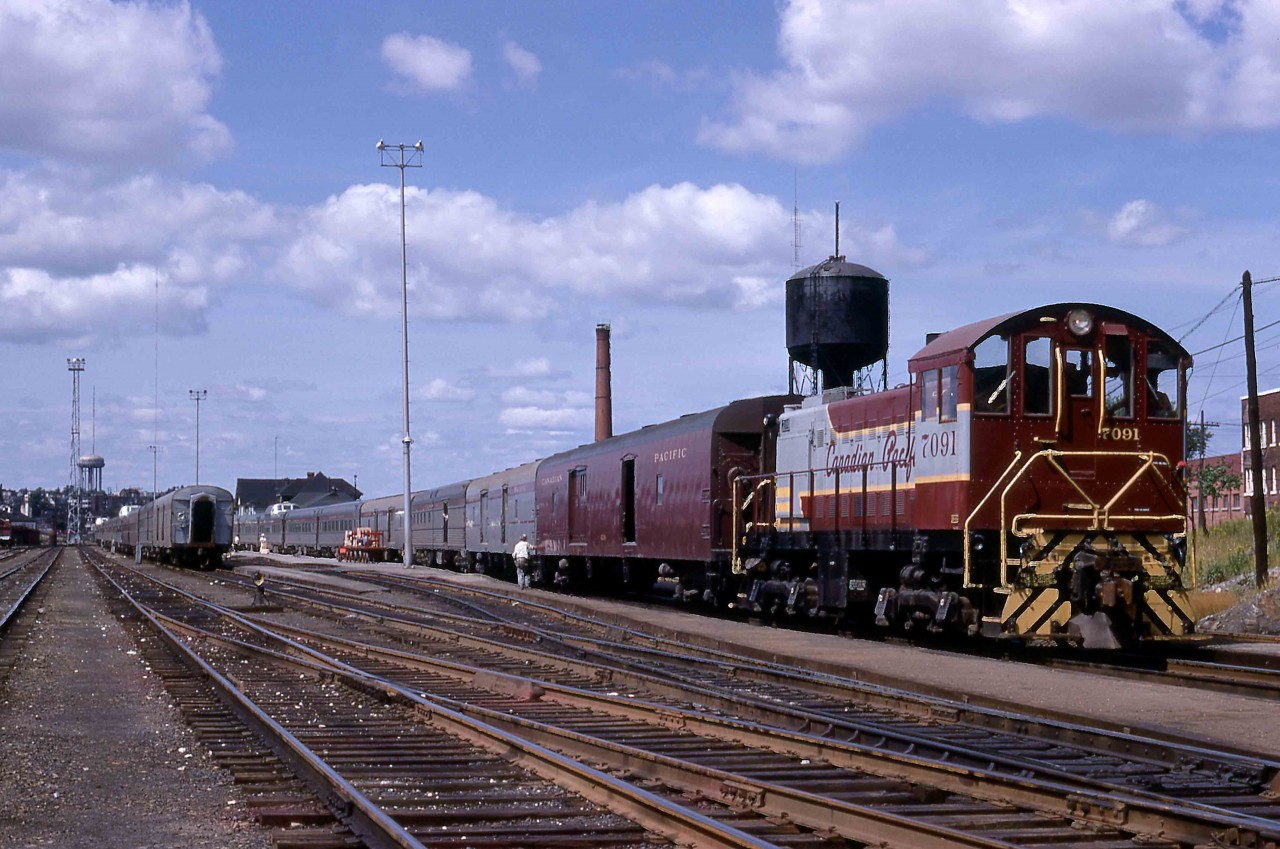|
Caption: At 11.10 a.m., Sunday, August 20, 1967, the eastbound Canadian, Train 2, rolled into town behind units 1406, 8567 and 1407. The schedule allowed thirty-five minutes for the splitting of the train into sections for Montreal and Toronto. They would depart on time with 1407 removed from the consist of Train 2 with FPA-2 4083 and RS-10 8561 leading Train 12 to Toronto. All units were steam generator equipped. 1407 would turn back west on the next Train 1 at 12.10 a.m. the following morning.
With the power pulled well east of the station, S-2 7091 (MLW 2-1949 #75866) went to work. Train 2 had arrived on the track closest to the station and the crew would rebuild it there. Train 12 would be readied for departure on the adjacent track. The usual three lightweight head-end cars, including two dormitory baggage cars, arrived on Train 2. Each outbound train had one dorm, and 7091 added a car behind the power on Train 2 and two behind the power on Train 12. Meanwhile, either 7090 or 7092 worked the other end of the Canadian.
Using the line numbers from the CPR's folder 62-28, the S-2 marshalled the following equipment into each train. The Toronto section included Sudbury - Toronto coach 223, coach 221 from Vancouver, Skyline cafe dome 222 from Sudbury. The following cars came from Vancouver: Manor cars 213, 212, Chateau 211, a diner, Manor 210, and Manor 202 from Regina and Park dome observation 200 from Sudbury. The Montreal section included coaches 226, 224, a Skyline, Chateaux 208 and 207, Manor 206, Chateau 205, a diner, Manor 204 and Park 201. Each of the 42 Manor cars from Budd's large order of 1954 included 4 roomettes, 5 double bedrooms, 1 compartment and 4 open sections. CPR's 29 Chateau sleepers featured 8 duplex roomettes, a drawing room with three berths, 3 double bedrooms and 4 open sections.
The Sunbury Star newspaper pictured the arrival of S-2s, 7090 through 7093 in 1949 not long after their construction and original assignment in Montreal. The 7090 through 7093 were soon assigned to Sudbury, but the latter soon moved on. By 1968, 7093 was in Toronto having worked in Smiths Falls. Reports vary on the assignment of 7094. Newspapers suggest that it was assigned to Smiths Falls with 7095 in late March 1949 but it is reported to have also come to Sudbury before moving to the Sault and then, by 1968, to Winnipeg.
The 1,000 horsepower, turbocharged 6-cylinder 539T diesel was first delivered as the S-2 model by Alco in September 1940. It came to MLW in Canada as CPR 7077 in May 1948 and it is preserved at Exporail near Montreal as Canada's first production diesel locomotive. Variations continued in production through April 1957, allowing it and the similarly powered S-4 and S-7 to come within a hair of besting EMD's SW7/9/1200 as North America's most numerous switcher. CP Rail sold 7091 to nearby Inco for use in its nickel production facility on Monday, June 16, 1986. It left their roster for scrapping in 2000 wearing number 204.
|



Yes, 35 minutes for all that work. I was always impressed with how quickly the CPR split or combined The Canadian in Sudbury. A few years ago I watched VIA switch one locomotive and add one deadhead car to our train in Jasper. It took well over an hour. While the modern electrical connections take time, in the days of steam heat it took some time to connect the steam pipes.
Safety and craft rules have changed railroading in so many ways. Conductors are typically the junior employees and two-man crews leave mentoring as largely something from a bygone era. I suspect things are generally similar in modern yards. Managers seem to be everywhere looking for infractions. Productivity is desired but elusive, I believe.